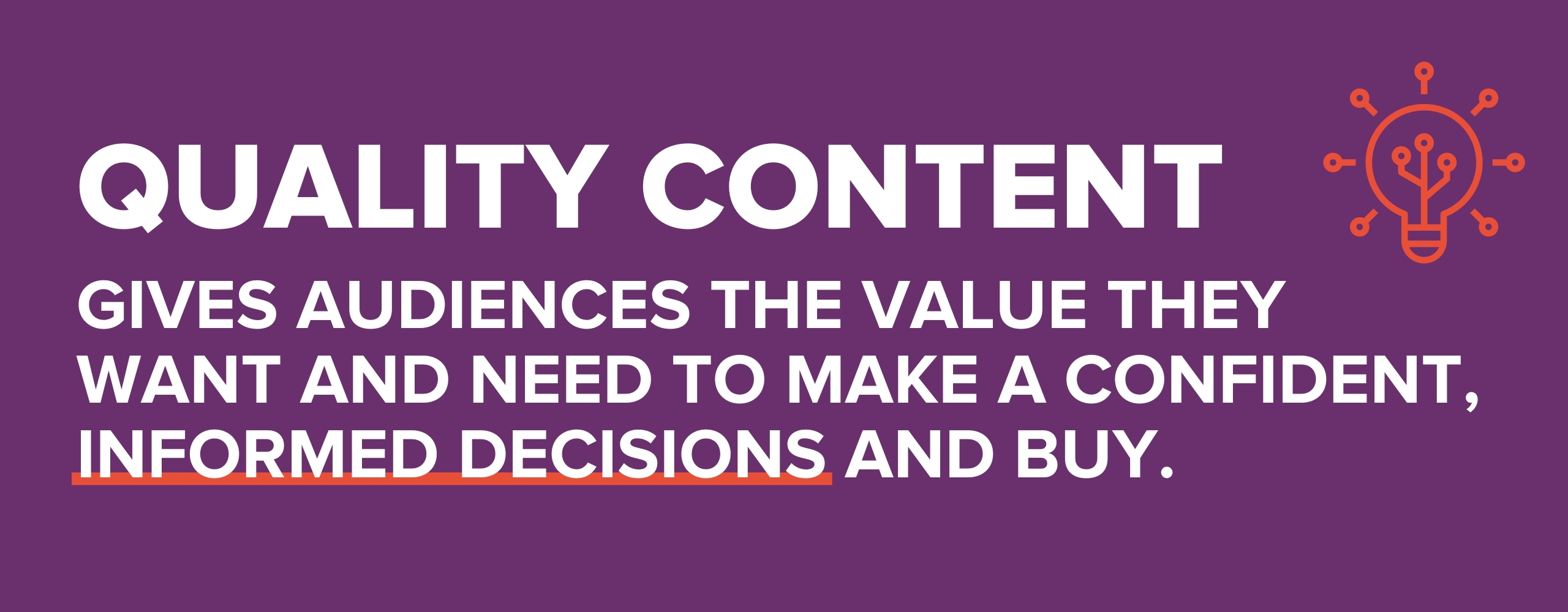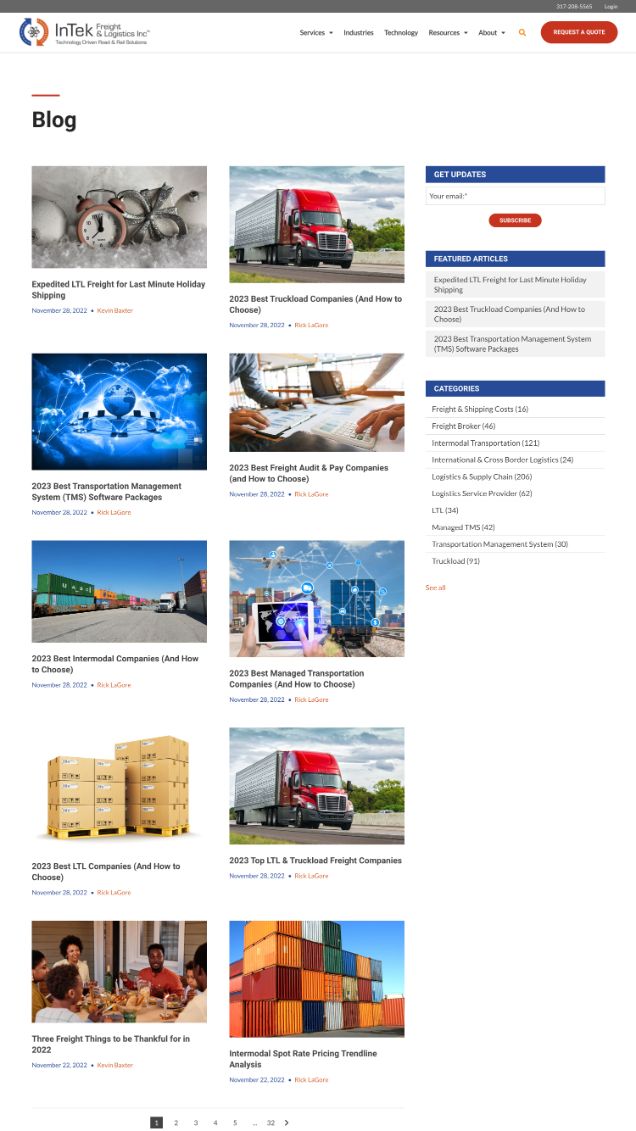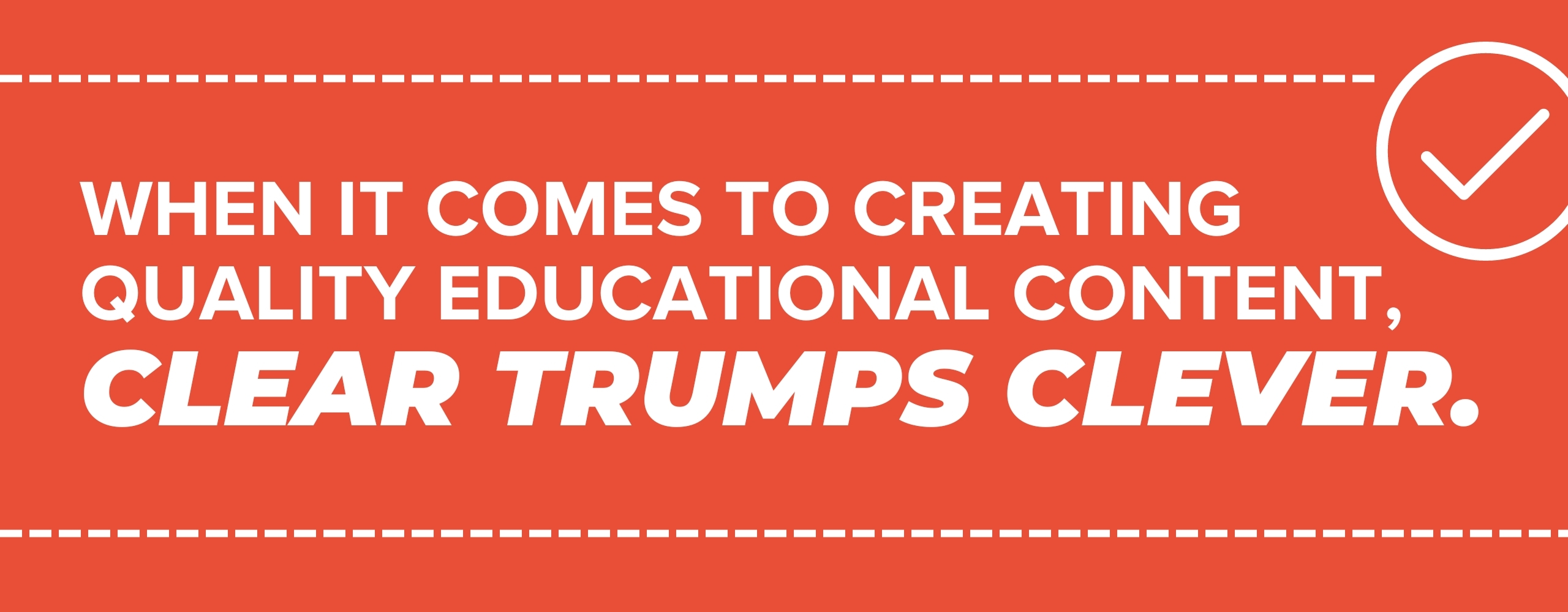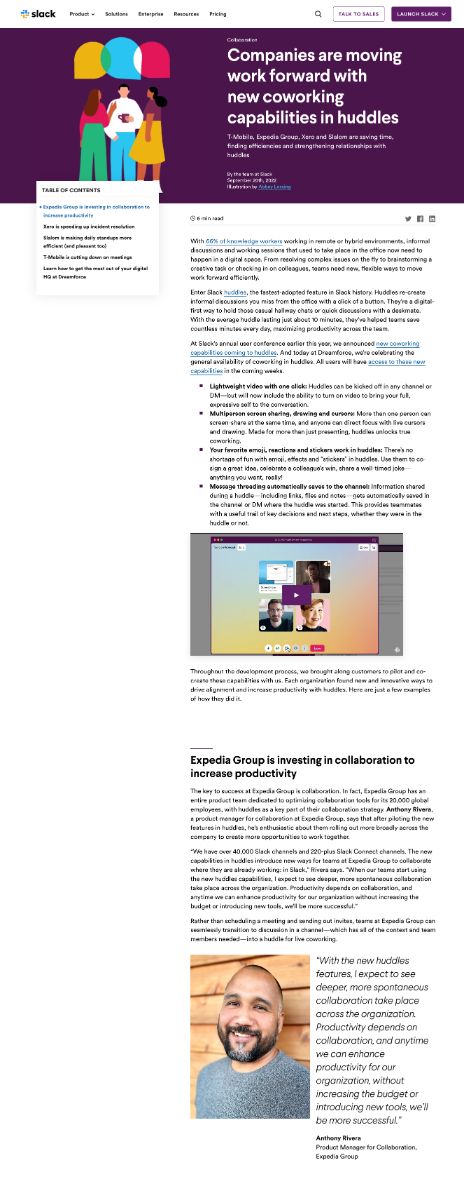Join 40,000+ sales and marketing pros who receive our weekly newsletter.
Get the most relevant, actionable digital sales and marketing insights you need to make smarter decisions faster... all in under five minutes.
What is 'Quality Content' Today?

Nov 2, 2022

The word “quality” is pretty subjective.
It could mean having a long list of traits that can be touched or seen, or it could be a warm and fuzzy feeling you can’t really describe.
In the case of content marketing, quality really comes down to two definitions:
- To Google (and most search engines), quality content gives the searcher what they’re looking for. It delivers the value that someone intends to find when they enter their query.
- For businesses, quality content drives traffic and, ultimately, sales.
But here’s the good news for marketers: Our experience and industry research shows that the content that truly valuable and helpful (what buyers and Google want), is the same content that sells (what businesses want).
In other words, they are no different. Quality content gives audiences the value they want and need to make a confident, informed decisions and buy.
Build trust by offering value
You see, it’s all about building trust.

Modern buyers don’t want to be sold to. They want to know they are spending their money wisely and making good decisions, not being bamboozled by a business that only cares about the sale.
They want to buy from (and stay loyal to) organizations that they trust will deliver on their promises.
When your content delivers true value — gives a buyer what they want rather than selling to them — they begin to view you as a helpful guide.
They begin to see that you want to help them make an educated buying decision, even if that decision doesn’t lead to a sale on your end. This trust is what ultimately makes people more inclined and comfortable buying from a business, and it's one of the biggest benefits of content marketing.
So, what kind of content is valuable to buyers?
Value is another thing that can be annoyingly vague. What is considered valuable varies depending on your audience and even its environment.
For example, during the initial rise of the COVID-19 pandemic, a study by Bain & Company found that “consumers across the global value[d] services, products, people, and institutions that: reduce anxiety, reduce risks, provide some sense of safety and belonging."
Under the circumstances, most people were looking for a very specific value at the time. Today, however, with vaccines available and life returning to a degree of normalcy in many parts of the world, that may no longer be the case.
These factors aside, value – when it comes to content marketing – usually comes in either the form of education or entertainment.
Thinking about the goal of content marketing, this makes sense.
Content marketing was birthed in an effort to share product information in a way that didn't feel like a sales pitch.
With buyers ignoring traditional marketing methods such as billboards and print ads, wrapping your messages in an educational or entertaining package is much more likely to reach your audience — without coming off as disingenuous.
How to create quality content
Entertaining content (think product placements or much of the content on social media) is more of a long-term play to selling. It helps build awareness naturally and keeps your audience engaged while educational content is more of a direct business play.
For this article, we'll focus primarily on the latter.
Quality educational content is hyper-focused on addressing people's questions, thoughts, and objections. For businesses, this usually means questions that come up when making a purchase and hopefully eliminating them. (Think using the content in assignment selling during the sales process.)
Educational content is about answering questions honestly and thoroughly to build trust with their audiences, because ultimately, people only want to buy from brands they know they can trust to deliver.
Below, I’ll share eight tips for creating high-quality content that does this.
While these can be applied to entertaining or educational content, they are especially effective for creating educational content that will help aid sales more immediately.
1. Answer buyer questions
This is the big one. Valuable educational content is rooted in answering the questions buyers have about your product, service, or industry.
If you can address the concerns in your buyer's head (especially those your competitors avoid addressing), you stand out as a trustworthy resource.
New research from Conductor has found that consumers are a whopping 131% more likely to buy from a brand immediately after they consume early-stage, educational content.
But what questions are people asking exactly? What should you be answering with your quality content?
The best way to find out is by talking to your salespeople and front-line team members to learn what buyers are asking about. But there are several areas popular regardless of your industry or business like discussing price, product comparisons, or product reviews.
IMPACT client InTek provides a great example of educational content in action. Their blog and resources are full of topics from The Big 5:

2. Be clear

I’m a writer and a marketer, so believe me when I say love wordplay.
But even with all my adoration, I know when it comes to creating quality educational content, clear trumps clever. (Though I still aim for a happy balance.)
To effectively educate your audience and have them fully grasp your messages, they need to be able to understand them. So, drop the jargon and SAT words.
Whenever possible, make sure to write in the simplest terms so that anyone can understand what you’re trying to say.
As Donald Miller explains in Building a StoryBrand, you don’t want your audience to burn too many calories trying to figure out what you’re trying to tell them.
Not only will any confusion leave a sour taste in a potential buyer’s mouth, but it may even make them bounce off the website and to a competitor. (And high bounce rates certainly don’t sit well with Google.)
3. Use formatting to make content easy to read
On a related note, make sure your content is easy to read as well.
Long paragraphs — or as I like to call them, not-so-great walls of text — can be intimidating and difficult to digest, especially on mobile devices. Use formatting and hierarchy to improve your user experience and make content easier to skim.
This can also make your content easier for search engines to understand what your page offers.
Here are some guidelines:
- Break up your content with headers. Not only l does this make it easier for the reader to find the information they need, but it also helps Google better understand the information on the page.
- Use bolding, italics, and underlining to emphasize important information. These help key points stand out.
- Keep paragraphs short. At IMPACT, we try not to exceed three visual lines, even if this ends up being just one sentence.
- Add visuals. Videos, images, charts, and other visual elements can help drive home your messages and also offer a visual break from the text for readers. Plus, science shows people process visuals 60,000 times faster than text and are more likely to remember the information shared in them.
- Use numbered or bulleted lists (such as this one) to organize and draw eyes to key information.
Messaging app company Slack does a great job of using formatting and visuals to make its content easier to read:

4. Be thorough
Quality content doesn’t just scratch the surface, it goes in-depth to address all of the obvious questions someone may have about a topic.
This doesn’t necessarily mean it directly shares every detail of a topic or has to be 5,000 words long, but it does offer substantial insight or guidance via a link or additional resource.
Again, the point here is to offer value. Quality content anticipates a user’s needs and intentions and makes sure it delivers that value.
One question I always ask myself when writing or reviewing content is "did this address all of my obvious questions?"
If the answer is yes, then it's done its job.
5. Make it actionable
When someone lands on your content, they are looking to solve a problem or learn more about something.
Often they are looking for a solution that they can implement or insights they can take action on immediately. Where many blogs fail is in creating content that isn’t actionable right away.
Quality content gives your audience something they can do as soon as they are finished). You don't have to provide life-changing advice in every post. Simply sharing a resource or providing step-by-step instructions is enough to keep the journey going.
Even if the next step is to download your free guide, the action they should take to get closer to their goal is clear.
When you offer valuable, tactical advice, you build trust with your reader. You want them to remember that when they landed on your article, they discovered something useful that benefited them that same day. The next time they want more information, your name and site will be top-of-mind.
6. Be relevant
Contrary to what Field of Dreams (and more importantly, Wayne’s World 2) said, just because you built it, doesn't mean people will come. In other words, just because you publish content doesn't mean anyone's going to read it.
Your piece could be perfectly formatted and written, but if it’s not something your audience actually cares about, it won’t be appreciated.
That being said, more than anything, quality content is content that is relevant. It speaks to your audience’s actual wants and needs, rather than simply communicating something you felt like talking about. (Though there are rare instances when that is OK.)
7. Support your claims
Marketers get a bad rap. Many consumers not familiar with the field or its nuances think we're just out to manipulate or trick people, but the best modern marketers know tricking a buyer hurts their organization in the long run.
That's why quality content supports everything it claims with accurate data, evidence, or examples from reliable sources.
No matter how established you may be, don't mindlessly shout hyperbole or insights without being able to explain where it's coming from.
Being able to prove everything you say once again builds trust and reinforces that you have your buyer's best interests in mind.
8. Be helpful
All in all, quality content helps your audience get where they want to go and know what they want to know. It helps them get the answers they're looking for regarding a purchase, even if that purchase isn't ultimately from you.
It is unbiased and gives the consumer all of the information they need to make the best decision for themselves.
Even Google recently released what it called the "helpful content update," urging creators to once again, focus on people-first content.
It explains:
"People-first content creators focus first on creating satisfying content, while also utilizing SEO best practices to bring searchers additional value.Answering yes to the questions below means you're probably on the right track with a people-first approach:
- Do you have an existing or intended audience for your business or site that would find the content useful if they came directly to you?
- Does your content clearly demonstrate first-hand expertise and a depth of knowledge (for example, expertise that comes from having actually used a product or service, or visiting a place)?
- Does your site have a primary purpose or focus?
- After reading your content, will someone leave feeling they've learned enough about a topic to help achieve their goal?
- Will someone reading your content leave feeling like they've had a satisfying experience?
So, not only will creating helpful content reward you in the eyes of buyers, but in the algorithms of Google as well.
Quality content makes money
At the end of the day, all of these tips are working toward the same goal: building trust to make money. Quality marketing content helps drive traffic, build trust, generate leads, and in the end, helps your organization close business.
You could have the greatest content marketing tools in the world, but if they're not being used to accomplish one of these goals, then they're not doing their job.
Want to dive deeper into the specifics of creating quality content? Check out our course, "Creating Memorable, Money-Making Content for Beginners."
Free Assessment: